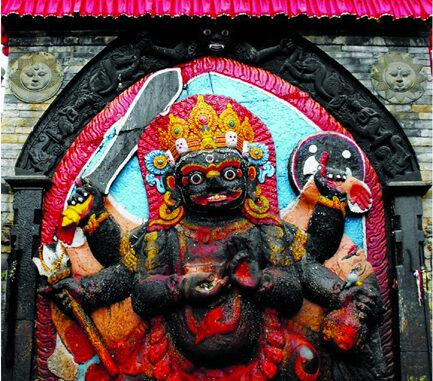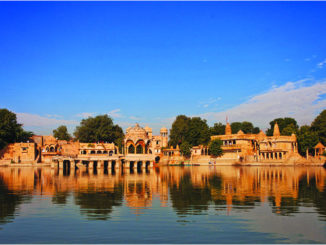
Bhairav Ashtami, also known as Bhairavashtami, Bhairava Jayanti, Kaal-Bhairava Ashtami and Kaal-Bhairava Jayanti, is the holy day of Hinduism that is the day of taking Bhairava, a sinister and angry incarnation of Lord Shiva. This day is celebrated as the birth anniversary of Bhairava. It falls on the fifteenth day (Ashtami) of the Hindu month of Kartik, in the fortnight of the decreasing moon (Krishna Paksha). Bhairav Ashtami falls on a single day in November, December or January. The name Kalashtami is sometimes used to refer to this day, but can also refer to any Ashtami in the Krishna Paksha, all these are the holy days of Bhairava, also known as Dandapani. Lord Bhairav’s vehicle is a dog, that is, Lord Bhairava rides a dog. Bhairava is the incarnation of Lord Shiva in the form of anger. It can be said that Bhairava is the manifestation of Lord Shiva’s wrath. According to the narrative narrated on this occasion, the trinity gods, Brahma, Vishnu and Shiva were talking in a serious mood about who was the best among them. In this debate, Shiva got a little angry with the comment made by Brahma and instructed his gana Bhairava to cut off one of the five heads of Brahma. Bhairava obeyed Shiva’s command and one head of Brahma was cut off and thus he became the four head. Filled with fear, all the others prayed to Shiva and Bhairava.
According to the legend, when Brahma insulted Shiva, Kaal Bhairava appeared from the forehead of the enraged Shiva and cut off Brahma’s head, leaving only four heads. Due to the sin of killing Brahma, Brahma’s head got stuck on the left palm of Bhairava – Brahmana or Brahmanism. To get rid of the sin of Brahmana, Bhairava had to fast for a Kapali. Wandering the world as a naked beggar with the skull of a beggar as his beggar. Bhairav’s sin comes to an end when he reaches the holy city of Varanasi, where a temple dedicated to him still exists.
Lord Bhairav or Bhairon is an incarnation (avatar) of Lord Shiva. Lord Bhairav is widely worshipped by tantriks and yogis to gain various siddhis. Bhairon is regarded as the protector and the kotwal. In astrology Lord Bhairav is the Lord of star (graha) Rahu so to attain the maximum benefits of Rahu, people worships Lord Bhairav. Bhairav is a fierce form of Shiva. It is believed that Bhairon is connected to the Mahavidya goddess named Bhairavi who gives Lagna shuddhi (purification of the follower). This purifies and protects the body, character, personality and other qualities associated with the follower. Worship of Lord Bhairon is very useful to win over your enemies, success and all materialistic comforts. It is very easy to please lord Bhairav by doing normal worship daily. Coconut, Flowers, Sindoor, Mustard oil, black til etc are offered to the God to get God’s Blessings. Bhairava himself has eight manifestations, Kala Bhairava, Asitanga Bhairava, Samhara Bhairava, Guru Bhairava, Krodh Bhairava, Kapala Bhairava, Rudra Bhairava and Unmatta Bhairava.
Origin of Lord Bhairav
The origin of Bhairava or Bhairon can be drawn from the conversation between Lord Brahma and Lord Vishnu described in “Shiv Maha-Puran” where Lord Vishnu asks Lord Brahma who is the supreme creator of the Universe. Lord Brahma proclaimed himself to be that superior person. On hearing this, Lord Vishnu chided Lord Brahma for his hasty and overconfident words. After the debate they decided to seek the answer from the four Vedas. Rig Veda designated Lord Rudra (Shiva) as supreme as He is the omnipotent deity who controls all living beings. Yajur Veda replied that He, whom we worship through various Yajnas (Yagna) and other such rigorous rituals, is none other than Shiva, who is supreme. Sam Veda stated that the respected figure who is worshipped by various Yogis and that Person who controls the entire world is none other than Triambakam (Shiva). Finally, Atharva Veda said, all human beings can see the Lord through Bhakti Marg and such a deity who can remove all the worries of human beings is indeed Shankar (Shiva). But both Lord Brahma and Lord Vishnu started laughing in disbelief.
Then Lord Shiva appeared as a powerful divine light. Lord Brahma stared at Him furiously with his fifth head. Lord Shiva immediately created one living being and stated that he will be King of Kaal and will be known as Kaal (Death) Bhairav. Meanwhile, Lord Brahma’s fifth head was still burning with fury and Kaal Bhairav pulled that head from Brahma. Lord Shiva directed Bhairav to go around various holy places (teerths) to get rid of Brahma Hatya. Kaal Bhairav, with Brahma’s head in his hand, started took bath in various holy places (Teerths), worshipped various Lords, nevertheless saw that Brahma Hatya Dosh was following him all along. He could not get rid of that affliction. Finally, Kaal Bhairav reached the Moksha Puri, Kashi. The moment Kaal Bhairav entered Kashi, Brahma Hatya Dosha disappeared into the netherworld. The head of Brahma, (Kapal) fell at a place which was called Kapal Mochan and there was a Teerth which was later called Kapal Mochan Teerth. Then onwards Kaal Bhairav stationed himself permanently in Kashi, giving shelter to all his devotees. Those living in or visiting Kashi, must worship Kaal Bhairav and he grants protection to all his devotees.
Ashtami day (eighth day after Purnima) in the month of Margashirsha is an important day for worshipping Kaal Bhairav. Besides, Sundays, Tuesdays, Ashtami and Chaturdasi days are very important for worshipping Kaal Bhairav. A person who circumambulates Lord Kaal Bhairav eight times will be absolved of all the sins committed by him. A devotee who worships Kaal Bhairav for six months will attain all types of Siddhi. (Kashi Khand, Chapter 31).
Another story of the origin of Bhairava is the tale of Shiva and Shakti. Shakti, the daughter of the king of gods, Daksha chosen Shiva for marriage. Her father disapproved the marriage because he alleged that Shiva resides in jungles with animals and ghosts and hence has no equality with him. But Shakti decides otherwise and marry Shiva. After some time King Daksha held a Yagna and invited all the gods, but not Shiva. Shakti came to the yagna alone, where Daksha publicly spoke in a belittling manner about Shiva. Shakti could not bear to hear her husband insult and jumped in the holy fire of Yagna and sacrificed her.
On hearing this Lord destroyed the yagna and killed Daksha by beheading him. Then Shiva carried Shakti’s corpse on his shoulders and ran uncontrollably all around the world for days. Since this would eventually destroy all creation, Vishnu used his Sudarshan Chakra to cut Shakti’s body into pieces, which then fell all around. These spots where Shakti’s body parts fell are now known as Shakti Peethas. In the form of the frightful Bhairava, Shiva is said to be guarding each of these Shakti Peeths. Each Shaktipeeth temple is accompanied by a temple dedicated to Bhairava (Bhairon).
There are eight types of Bhairava and they are called ashta Bhairava. They are Asithanga Bhairavar, Ruru Bhairavar, Chanda Bhairavar, Krodh Bhairava, Unmatta Bhairavar, Kapala Bhairavar, Bhishana Bhairavar and Samhara Bhairavar. Apart from these eight forms there is yet another form called Swarna akarshana Bhairavar. Maha Bhairavar is said to be Shiva himself.
He is also the “Aapaduddhaarana murti” – the one who uplifts us in times of crisis. He averts all kinds of dangers. The one who worships Swarna akarshana Bhairava gets everything. He gets all the wealth and richness in his life and also is constantly protected from all the perils in his life. Above all, because Swarna akarshana Bhairava is the one of the Bhairava – the terrifying ones – he liberates us from all the patterns and karmas causing the cycle of birth and death.





Be the first to comment